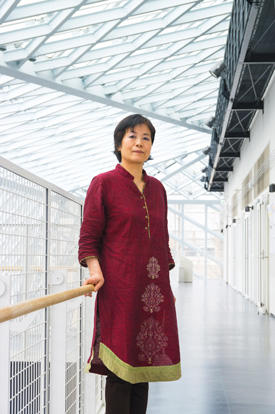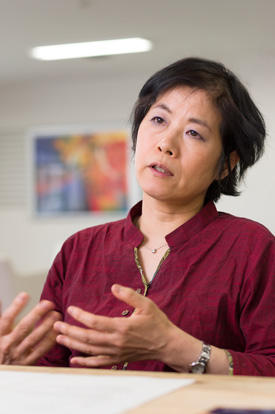

05/25/2015
After an eventful year in which the AIMR was evaluated as having met the rigorous conditions for ‘World Premier Status’, Director Kotani reflects on the institute’s strengthened international research network and its strategy for the year ahead.

AIMResearch: In 2014, the World Premier International Research Center Initiative (WPI) program committee conducted a major evaluation of five WPI centers and concluded that the AIMR had achieved World Premier Status. What is the significance of this assessment?
I am very gratified that the AIMR has been recognized as a globally visible, international research hub for world-class materials science. Achieving World Premier Status represents a very special milestone for us, as it recognizes the effectiveness of our approach in realizing the mission of the WPI.
A key objective of the WPI program is to produce top-quality science, which has always been an extremely high priority at the AIMR. Researchers at the AIMR have published many highly cited scientific papers in prestigious journals such as Science, Nature and Nature-branded sister journals, in addition to receiving internationally acclaimed awards. For example, three AIMR researchers were listed in Thomson Reuters’ Highly Cited Researchers last year. Also, Mingwei Chen won the Materials Today Conference Award for his outstanding contributions to the field of materials science, while Shin-ichi Orimo was awarded the Science of Hydrogen & Energy Award 2015.
The WPI program committee also recognized that the AIMR has achieved a high level of internationalization. We have made a great effort to recruit outstanding researchers from around the world, and now almost half of AIMR researchers come from abroad. Moreover, we promote international joint research projects through AIMR Joint Research Centers in China, the United Kingdom and the United States, together with a network of 15 overseas partner institutions.
The WPI program actively seeks to break down the boundaries between traditional disciplines by engaging in cross-disciplinary research. At the AIMR, we emphasize the use of mathematics in materials science research and have initiated three Target Projects to ensure closer mathematics–materials science collaboration. Mathematics is a very powerful tool for guiding materials science research. The committee recognized our remarkable progress in establishing a unique and convincing identity within a short time.
Our proactive efforts to introduce system reforms at the AIMR were also crucial to achieving World Premier Status. Among other initiatives, we have introduced a top-down approach to decision making, established a merit-based salary system and adopted English as our official language. In this, we have received strong backing from our host institute, Tohoku University.
AIMResearch: What are some ways that the AIMR has been promoting collaboration with overseas researchers and institutions?
Collaboration is not just about establishing friendships but also about engaging more deeply in joint research. International collaboration occurs on various levels at the AIMR. We encourage our researchers to initiate conversations and identify mutual areas of interest with other researchers in their field. Many of our principal investigators are jointly affiliated with an overseas institution. At the institutional level, we try to be selective with our alliances, setting up key long-term partnerships with distinguished research institutes that will bring us closer to achieving our research goals. Last April, we signed an agreement with the University of Chicago to establish a Joint Research Center, which will be a valuable addition to our existing partnerships with the University of Cambridge, the Institute of Chemistry at the Chinese Academy of Sciences and the University of California, Santa Barbara.
AIMResearch: Are there any upcoming events that you are excited about?
In May, we will enter into a formal agreement with Harvard University as well as participate in a joint workshop on the emerging field of quantum materials and devices.
The coming year will also see major developments in spin-centered science, which has been an important area of research for the AIMR. Prominent condensed-matter physicists such as Sir Michael Berry — whose discoveries have been groundbreaking for the realization of spintronic devices — were invited to speak at our annual AIMR International Symposium in February 2015. And the Tohoku Forum for Creativity is organizing a forum on spintronics from September to December 2015, in which leading scientists will be invited to share and discuss their latest findings in spin-related phenomena. The program committee is made up of researchers from the AIMR and Tohoku University.
Tohoku University is the only Japanese member of SpinNet, a tight-knit international network that seeks to develop energy-efficient spin-based technologies and support the education of students and researchers in the field. Established in 2013, the network is sustained by a one million euro commitment from the German government over four years. In February 2015, Tohoku signed an agreement with a partner institute of SpinNet — Johannes Gutenberg University of Mainz in Germany — to launch a jointly supervised PhD program in the natural sciences and engineering, with an emphasis on spintronics.

AIMResearch: What do you intend to focus on this year?
This year, I want to put more emphasis on the realization of our unique approach. I am more interested in adopting a potentially revolutionary approach to materials science than in studying specific materials. The sheer complexity of materials systems has meant that, in the past, most research in materials science has progressed on the basis of unguided trial and error. But now that the relevant areas of mathematics have matured, we can use mathematics to conduct research on materials in a more directed manner.
This has the potential to save a lot of time in the laboratory. Tohoku University is very strong in the field of materials science and its researchers have generated vast amounts of experimental data. But this data cannot be used effectively without appropriate descriptions. The AIMR seeks to provide materials scientists with the necessary vocabulary for systematic discovery and design of materials.
Mathematics is a kind of treasure box containing tools known only to mathematicians. I would like to open this treasure box to materials scientists and help them discover new applications. Take, for example, the emerging field of persistent homology, which is a new subject even for mathematicians. Unlike the situation in theoretical physics, in materials science it is not possible to create ideal conditions or environments. Real systems contain many impurities and defects, which means that researchers have to abstract the robust properties of a system. As a field concerned with robust topology, persistent homology offers a powerful tool for materials scientists.
This year, I would like to focus on proving that materials–mathematics fusion research is more effective than the traditionally split approach. Of course, this is a very difficult undertaking, but I am a mathematician so I have to prove things.